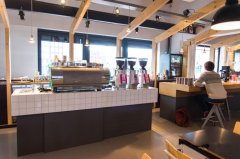Boutique coffee knowledge what is decaf and how to handle it
Decaf coffee, as its name implies, is coffee with only a small amount of caffeine. Coffee contains many ingredients and substances, among which caffeine has an obvious effect on the human body. For many people who are addicted to coffee but whose physical condition does not allow caffeine, decaf is the best choice.

In general, Arabica coffee beans contain 1.1%-1.7% caffeine, while robusta beans contain 2%-4.5% d caffeine. Decaf coffee is required to contain no more than 0.3% caffeine in brewed coffee. That means no more than 5 milligrams of caffeine in a cup of decaf.
The step of low-cause treatment can only be carried out in the state of sub-coffee and raw beans. Today, there are three main types of treatments to remove caffeine: traditional / European treatment (European Process), Swiss water treatment (SWP,Swiss Water Process), and CO supercritical Process (CO2 supercritical treatment). All three methods are very effective in removing most caffeine, leaving only 20.3% of the total amount of original caffeine in coffee beans.
European / solvent treatment (The European or Solvent Process): there are two variations in solvent treatment. The first is direct solvent treatment. First, the stomata of raw coffee beans are opened with steam, and the solvent is directly added to the coffee beans. After the solvent is fused with caffeine, it is brought out by steam. The other is indirect solvent treatment, in which all the flavors of raw coffee beans are dissolved in hot water (this is a hypothetical state, not all compound beans are really dissolved out), and after a period of time, raw coffee beans are separated from hot water with "all" flavors (including caffeine), and then a solvent that attracts caffeine is added to the hot water. At this point, caffeine binds to the solvent and rises to the surface, which can be easily removed, and then the decaffeinated hot water is recombined with raw coffee beans, which absorb the remaining flavor factors.
Swiss Water treatment method (The Swiss Water-Only Process): using this commercially developed and efficient treatment method, there are two major steps. The first step is to pour the raw coffee beans into hot water, which will remove almost all the flavor factors in the raw coffee beans, including caffeine, and discard the original batch of raw coffee beans. After that, the hot water loaded with all flavor factors is filtered out by activated carbon filter, and the rest is hot water full of pure flavor factors, which is called "flavor full water" (Flavor-charged Water) in Swiss water treatment. This kind of water contains all the flavor factors that should be found in raw coffee beans, except for caffeine, which is a special water. Is the most important medium in the next decaffeinated process.
A new batch of raw coffee beans soaked in water full of flavor factors and non-caffeine will release caffeine in raw coffee beans, but will not release flavor factors. In this way, the original flavor of raw coffee beans will not be impaired too much. Obviously, the flavor factor in the flavor-loaded water is already close to saturation, so it can no longer dissolve more flavor factors, but there is still a lot of room to dissolve caffeine.
After this process of removing caffeine and retaining flavor factors, raw coffee beans are dried and sold directly, while the flavor that absorbs caffeine is filled with water, which can be removed by activated carbon filter over and over again.
Carbon dioxide supercritical Process (CO supercritical carbon dioxide): carbon dioxide supercritical treatment is to soak raw coffee beans in liquid carbon dioxide. Under high pressure, carbon dioxide presents a semi-gaseous and semi-liquid state, in which carbon dioxide can actively combine with caffeine, and caffeine is finally removed by an exhaust activated carbon filter.
Either way, the extracted caffeine is resold to cola or pharmaceutical companies for reuse, and caffeine is not wasted at all. As for the flavor of decaf coffee, Viagra can only be said to be unflattering here. You can't have both fish and bear's paw. Since you need decaf coffee more, you can only give up the flavor.
The second part will talk about the choice of low-caffeine coffee and the effect of different treatments on flavor.
Important Notice :
前街咖啡 FrontStreet Coffee has moved to new addredd:
FrontStreet Coffee Address: 315,Donghua East Road,GuangZhou
Tel:020 38364473
- Prev

Knowledge of the theoretical ratio of powder to water in coffee brewing SCAA gold cup
The proportion of SCAA refined cup coffee defined by the Gold Cup Fine Coffee Association of the United States and the European Fine Coffee Association of scae, the extraction rate of coffee must be about 20%, while the TDS (concentration ratio) is about 1.1% to 1.3%. For Drip Filter dripping and brewing, how to extract the best coffee flavor, the controlling factors are nothing more than the changes of the extract of coffee powder and the concentration in a cup of coffee.
- Next

Boutique coffee shop management foreign bar example appreciation
Especially appreciate foreign coffee bar, whether cool wind, or simple wind, the weapons used (coffee utensils) are very enough weight, especially attractive.
Related
- Beginners will see the "Coffee pull flower" guide!
- What is the difference between ice blog purified milk and ordinary milk coffee?
- Why is the Philippines the largest producer of crops in Liberia?
- For coffee extraction, should the fine powder be retained?
- How does extracted espresso fill pressed powder? How much strength does it take to press the powder?
- How to make jasmine cold extract coffee? Is the jasmine + latte good?
- Will this little toy really make the coffee taste better? How does Lily Drip affect coffee extraction?
- Will the action of slapping the filter cup also affect coffee extraction?
- What's the difference between powder-to-water ratio and powder-to-liquid ratio?
- What is the Ethiopian local species? What does it have to do with Heirloom native species?

